Menu
-
MenuBack
- Home
-
Categories
-
-
Categories
-
Vegetable Seeds
-
Varieties by Country
- Varieties from Armenia
- Varieties from BiH
- Varieties from Croatia
- Varieties from France
- Varieties from Germany
- Varieties from Greece
- Varieties from Hungary
- Varieties from India
- Varieties from Italy
- Varieties from Japan
- Varieties from North Macedonia
- Varieties from Peru
- Varieties from Russia
- Varieties from Serbia
- Varieties from Slovenia
- Varieties from Spain
- Varieties from Thailand
- Varieties from Turkey
- Varieties from USA
- Tomato Seeds
- Corn Seeds
- Gourd family
- Bean family
- Cucumber Seeds
- Pepper Seeds
- Carrot family
- Onion family
- Lettuce Seeds
- Potato family
- Cabbage family
- Radish Seeds
- Beetroot family
- Watermelon Seeds
- Melon Seeds
- Cauliflower Seeds
- Sunflower family
-
Varieties by Country
- Fruit Seeds
- Chili - Habanero Seeds
- Medicinal Herb Seeds
- Climbing Plants Seeds
- Trees Bonsai Seeds
- Palm Seeds
- Ornamental Grasses Seeds
- Tobacco Seeds
-
Vegetable Seeds
-
-
-
-
- NEW PRODUCTS
- Create account
- Delivery - Payment
- FAQ
- Home
-
- Vegetable Seeds
- Varieties by Country
- Varieties from North Macedonia
- Varieties from Croatia
- Varieties from Turkey
- Varieties from BiH
- Varieties from Japan
- Varieties from India
- Varieties from Armenia
- Varieties from France
- Varieties from Slovenia
- Varieties from Serbia
- Varieties from Greece
- Varieties from Russia
- Varieties from Italy
- Varieties from Spain
- Varieties from USA
- Varieties from Germany
- Varieties from Peru
- Varieties from Thailand
- Varieties from Hungary
- Cauliflower Seeds
- Melon Seeds
- Watermelon Seeds
- Sunflower family
- Beetroot family
- Radish Seeds
- Tomato Seeds
- Corn Seeds
- Gourd family
- Bean family
- Cucumber Seeds
- Pepper Seeds
- Cabbage family
- Potato family
- Onion family
- Lettuce Seeds
- Carrot family
- Varieties by Country
- Packaging and stuff
- Mushroom Mycelium
- Plant Bulbs
- Organic Spices
- Ayurveda Plants
- F1 Hybrid Seeds
- Banana Seeds
- No PayPal and Card payment X
- Giant Plants Seeds
- Cold-resistant plants
- Bamboo seeds
- Fruit and vegetable molds
- Large Packets of Seeds
- Fruit Seeds
- Chili - Habanero Seeds
- Medicinal Herb Seeds
- Climbing Plants Seeds
- Trees Bonsai Seeds
- Palm Seeds
- Ornamental Grasses Seeds
- Tobacco Seeds
- Delivery - Payment
- Sowing Instructions
- Plants Care
- Water plants seeds
- Cactus Seeds
- Flower Seeds
- Vegetable Seeds
Last Product Reviews
These peppers came all the way from eastern Europe and took a while at no f...
By
 Fitim Berani on 21/09/2023
Fitim Berani on 21/09/2023
Verified Purchase
Last customers
- Tanja, Beograd, Serbia
- Pete, Cleves, United States
- Stef, Waalwijk, Netherlands
- Sonia, Minervino di Lecce, Italy
- Adrian, Ingolstadt, Germany
- CORINNE, NOTRE DAME DE LONDRES, France
- Dušan, KRAVANY NAD DUNAJOM, Slovakia
- Arno, Ehrenkirchen, Germany
- Costas, LARNACA , Cyprus
- Fulvio francesco, Santa Domenica Talao, Italy
- william, Dun, France
- Aymeric , Saint tricat, France
- Ricard, Sant Celoni, Spain
- Maureen, Enniscorthy Co Wexford , Ireland
- Paul, St. Vigil in Enneberg (BZ), Italy
- Ricardo jorge , Viseu , Portugal
- Radosav, Kragujevac, Serbia
- Sylvie, Neyruz, Switzerland
- Julien, Scionzier, France
- Zoran, Vinca, Serbia
- Josef, Hochdorf-Assenheim, Germany
- Davide, London, United Kingdom
- Kimberly, Victoria, Gozo, Malta
- Saša , Beograd, Serbia
- Ewa, Galway, Ireland
- Ioannis , Kato Achaia, Greece
- Samuele, Milano, Italy
- Dubravka, Niš , Serbia
- Theodoros, Grevena, Greece
- goderis, bredene, Belgium
There are 1756 products.
Showing 1705-1716 of 1756 item(s)
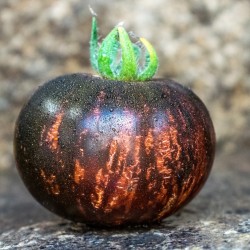
Queen Of The Night Tomato...
Price
€1.85
SKU: VT 123
Seeds Gallery Com,
5/
5
<h2><strong>Queen Of The Night Tomato Seeds</strong></h2>
<h2><span style="color: #f80000;"><strong>Price for a Package of 10 seeds.</strong></span></h2>
Königin der Nacht - Queen Of The Night is a recent blue variety from the Rhine area, Germany. What we know for sure is that this new variety comes from Germany from the Rhine area and further information is unknown.<br><br>The round red-orange striped fruits with very strong blue-black influences on the upper half from anthocyanin. The more the fruits are exposed to sunlight, the stronger this antioxidant (the same as blueberries) the more the fruits will turn blue/black.<br><br>Dens flesh but very juicy with a strong tomato flavor.<br><br>Medium sized indeterminate growing plants of about 1.5 m to 1.75 m with high yields reasonably early in the season, yet for a blue variety.<script src="//cdn.public.n1ed.com/G3OMDFLT/widgets.js"></script>
VT 123 (10 S)


Variety from America
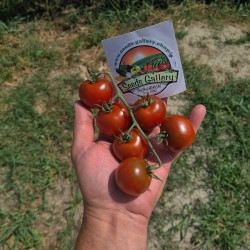
Campari tomato seeds
Price
€1.85
SKU: VT 124
Seeds Gallery Com,
5/
5
<h2><strong>Campari tomato seeds</strong></h2>
<h2 class=""><span style="color: #ff0a0a;"><strong>Price for a Package of 10 seeds.</strong></span></h2>
<div>Campari is a type of tomato, noted for its juiciness, high sugar level, low acidity, and lack of mealiness. Camparis are deep black-red and larger than a cherry tomato, but smaller and rounder than a plum tomato. They are often sold as "tomato-on-the-vine" (TOV) in supermarkets, a category of tomato that has become increasingly popular over the years. Campari tomatoes can be produced from different varieties with similar characteristics, the standard being Mountain Magic. As a hybrid, the seeds cost around $150,000 per pound.</div>
<div></div>
<div>The company Mastronardi Produce registered the term "Campari" as a United States trademark for its tomatoes in 2003; however, the trademark was challenged in 2006 based on claims that "Campari" is actually the general name for the tomato variety bred in the 1990s by the Dutch company Enza Zaden.</div>
<div></div>
<div>Characteristics</div>
<div>A typical Campari cultivar is globe-shaped, with regular leaves, and exhibits resistance to the tobacco mosaic virus. The plant grows 6–8 feet (1.8–2.4 m) and matures in 70–80 days.</div>
<script src="//cdn.public.n1ed.com/G3OMDFLT/widgets.js"></script>
VT 124 (10 S)

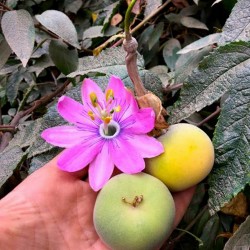
Tauso Seeds (Passiflora...
Price
€3.50
SKU: V 120
Seeds Gallery Com,
5/
5
<h2 class=""><strong>Tauso Seeds (Passiflora coactilis)</strong></h2>
<h2><span style="color: #ff0a0a;"><strong>Price for Package of 3 seeds.</strong></span></h2>
A vigorous, evergreen climber with trilobed leaves and pink flowers followed by round, yellowish fruits that are edible and aromatic. Passiflora coactilis is a plant from cool, high elevation cloud forests in the Andes in South America in southwestern Colombia and in Ecuador between 2200 and 3600 m. it is well adapted to cool conditions and will grow in many warm temperate climates in USDA Zones 9 and above. <br><br><strong>In frosty weather, leaves and shoots may be damaged but will regrow from the base in spring.</strong>
<script src="//cdn.public.n1ed.com/G3OMDFLT/widgets.js"></script>
V 120 (3 S)

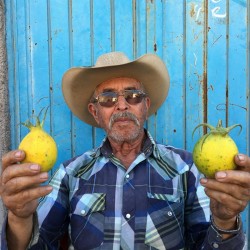
Jarilla Seeds (Jarilla...
Price
€7.95
SKU: V 72
Seeds Gallery Com,
5/
5
<h2 class=""><strong>Jarilla Seeds (Jarilla caudata)</strong></h2>
<h2><span style="color: #ff0a0a;"><strong>Price for a Package of 3 seeds.</strong></span></h2>
Jarilla caudata is a rather unspectacular plant and papaya relative with quite extraordinary and highly unusual fruits. An upright or creeping, dry deciduous, herbaceous perennial, native to Mexico and Central America, where it grows in xerophytic scrubland and deciduous forests, at elevations between 1500 and 2000 m. <br><br>Similar to Jarilla heterophylla, it produces a succulent tuber that holds green or purplish-green stems branching from the base with oval to lanceolate leaves and whitish flowers with occasional streaks of purple. The flowers are followed by oblong to elliptical fruits that can reach up to 30 cm in length, with long, horn-like projections. They are mottled in lighter and darker shades of green and turn yellow when ripe while the "horns" turn purplish. <br><br>The fruits are edible and occasionally found in local markets. Soft fruits are eaten raw while fully mature ones are used to make a refreshing beverage from their juice. According to one old Mexican recipe, Jarilla caudata fruits can also be used to make preserves and they are especially delicious when combined with coconut. <br><br>This relative of the papaya will grow well in most warm temperate climates to at least USDA Zone 9 and even survive some drought and cold. It would be an interesting species for hybridization with other papaya relatives.
<script src="//cdn.public.n1ed.com/G3OMDFLT/widgets.js"></script>
V 72 (3 S)

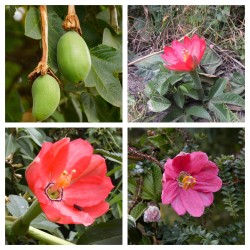
Tumbo Seeds (Passiflora mixta)
Price
€3.50
SKU: V 83
Seeds Gallery Com,
5/
5
<h2 class=""><strong>Tumbo Seeds (Passiflora mixta)</strong></h2>
<h2><span style="color: #ff0a0a;"><strong>Price for a Package of 3 seeds.</strong></span></h2>
<br>Passiflora mixta is well adapted to cool conditions and will grow in many warm temperate climates in USDA Zones 9 and above.<br><br>Tags: child and pet friendly, climber, edible fruit, evergreen, flowering, malpighiales, mixta, ornamental, passiflora, potted, tumbo...<br><br>
<h2 style="color: #1a1a1a; font-size: 30px;"><span class="mw-headline" id="Germination">Germination</span></h2>
<p style="color: #333333; font-size: 16px;"><i>Passiflora mixta</i><span> </span>seeds take approximately 30–365 days to germinate and even under optimal conditions their growth may be erratic. The seeds should be planted 6 mm (0.24 in) deep in a peaty seed sowing mix at about 20–30 °C (68–86 °F). new water should be used every day and it is necessary to soak them under warm water. This process will cause some seeds to swell up; these seeds should be sown instantly. On occasion, it is also important to soak the container in which the seeds are placed.<span> </span></p>
<script src="//cdn.public.n1ed.com/G3OMDFLT/widgets.js"></script>
V 83 (3 S)

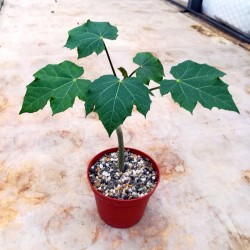
Physic nut, Barbados nut...
Price
€3.75
SKU: T 92
Seeds Gallery Com,
5/
5
<h2><strong>Physic nut, Barbados nut Seeds (Jatropha curcas)</strong></h2>
<h2><span style="color: #ff0a0a;"><strong>Price for a Package of 3 seeds.</strong></span></h2>
<p style="color: #202122; font-size: 14px;"><i><b>Jatropha curcas</b></i><span> </span>is a species of<span> </span>flowering plant<span> </span>in the<span> </span>spurge<span> </span>family,<span> </span>Euphorbiaceae, that is native to the<span> </span>American tropics, most likely<span> </span>Mexico<span> </span>and<span> </span>Central America.<sup id="cite_ref-Janick_2-0" class="reference" style="font-size: 11.2px;">[2]</sup><span> </span>It is originally native to the tropical areas of the Americas from Mexico to Argentina, and has been spread throughout the world in tropical and<span> </span>subtropical<span> </span>regions<span> </span>around the world, becoming<span> </span>naturalized or invasive<span> </span>in many areas.<sup id="cite_ref-cabi_3-0" class="reference" style="font-size: 11.2px;">[3]</sup><span> </span>The<span> </span>specific epithet,<span> </span><i>"curcas"</i>, was first used by<span> </span>Portuguese<span> </span>doctor<span> </span>Garcia de Orta<span> </span>more than 400 years ago.<sup id="cite_ref-Agroforest_4-0" class="reference" style="font-size: 11.2px;">[4]</sup><span> </span>Common names in English include<span> </span><b>physic nut</b>,<span> </span><b>Barbados nut</b>,<span> </span><b>poison nut</b>,<span> </span><b>bubble bush</b><span> </span>or<span> </span><b>purging nut</b>.<sup id="cite_ref-cabi_3-1" class="reference" style="font-size: 11.2px;">[3]</sup><span> </span>In parts of Africa and areas in Asia such as India it is often known as "castor oil plant" or "hedge castor oil plant",<sup id="cite_ref-cabi_3-2" class="reference" style="font-size: 11.2px;">[3]</sup><span> </span>but it is not the same as the usual<span> </span>castor oil plant,<span> </span><i>Ricinus communis</i><span> </span>(they are in the same family but different subfamilies).</p>
<p style="color: #202122; font-size: 14px;"><i>J. curcas</i><span> </span>is a semi-evergreen<span> </span>shrub<span> </span>or small<span> </span>tree, reaching a height of 6 m (20 ft) or more.<sup id="cite_ref-Janick_2-1" class="reference" style="font-size: 11.2px;">[2]</sup><span> </span>It is resistant to a high degree of<span> </span>aridity, allowing it to grow in<span> </span>deserts.<sup id="cite_ref-5" class="reference" style="font-size: 11.2px;">[5]</sup><sup id="cite_ref-6" class="reference" style="font-size: 11.2px;">[6]</sup><span> </span>It contains<span> </span>phorbol esters, which are considered toxic.<sup id="cite_ref-7" class="reference" style="font-size: 11.2px;">[7]</sup><span> </span>However, edible (non-toxic) provenances native to Mexico also exist, known by the local population as piñón manso, xuta, chuta, aishte, among others.<sup id="cite_ref-Martínez-Herrera,_J._2010_8-0" class="reference" style="font-size: 11.2px;">[8]</sup><sup id="cite_ref-valdez2013_9-0" class="reference" style="font-size: 11.2px;">[9]</sup><span> </span><i>J. curcas</i><span> </span>also contains compounds such as<span> </span>trypsin inhibitors,<span> </span>phytate,<span> </span>saponins<span> </span>and a type of<span> </span>lectin<sup id="cite_ref-10" class="reference" style="font-size: 11.2px;">[10]</sup><sup id="cite_ref-11" class="reference" style="font-size: 11.2px;">[11]</sup><span> </span>known as curcin.<sup id="cite_ref-12" class="reference" style="font-size: 11.2px;">[12]</sup></p>
<p style="color: #202122; font-size: 14px;">The<span> </span>seeds<span> </span>contain 27–40%<span> </span>oil<sup id="cite_ref-13" class="reference" style="font-size: 11.2px;">[13]</sup><span> </span>(average: 34.4%<sup id="cite_ref-14" class="reference" style="font-size: 11.2px;">[14]</sup>) that can be processed to produce a high-quality<span> </span>biodiesel<span> </span>fuel, usable in a standard<span> </span>diesel engine. Edible (non-toxic) varieties can be used for<span> </span>animal feed<span> </span>and food.</p>
<h2 style="color: #000000; font-size: 1.5em;"><span class="mw-headline" id="Botanical_features">Botanical features</span></h2>
<ul>
<li>Leaves: The leaves have significant variability in their morphology. In general, the leaves are green to pale green, alternate to subopposite, and three- to five-lobed with a<span> </span>spiral phyllotaxis.<sup id="cite_ref-Nahar_16-0" class="reference" style="font-size: 11.2px;">[16]</sup></li>
<li>Flowers: male and female flowers are produced on the same<span> </span>inflorescence, averaging 20 male flowers to each female flower,<sup id="cite_ref-Pesquisa_17-0" class="reference" style="font-size: 11.2px;">[17]</sup><span> </span>or 10 male flowers to each female flower.<sup id="cite_ref-Jatropha_journal_18-0" class="reference" style="font-size: 11.2px;">[18]</sup><span> </span>The inflorescence can be formed in the<span> </span>leaf axil. Plants occasionally present hermaphroditic flowers.<sup id="cite_ref-Nahar_16-1" class="reference" style="font-size: 11.2px;">[16]</sup></li>
<li>Fruits : fruits are produced in winter, or there may be several crops during the year if soil moisture is good and temperatures are sufficiently high. Most fruit production is concentrated from midsummer to late fall with variations in production peaks where some plants have two or three harvests and some produce continuously through the season.<sup id="cite_ref-Nahar_16-2" class="reference" style="font-size: 11.2px;">[16]</sup></li>
<li>Seeds: the seeds are mature when the capsule changes from green to yellow. The seeds contain around 20% saturated fatty acids and 80% unsaturated fatty acids, and they yield 25–40% oil by weight. In addition, the seeds contain other chemical compounds, such as<span> </span>saccharose,<span> </span>raffinose,<span> </span>stachyose,<span> </span>glucose,<span> </span>fructose,<span> </span>galactose, and<span> </span>protein. The oil is largely made up of oleic and<span> </span>linoleic<span> </span>acids. Furthermore, the plant also contains curcasin, arachidic,<span> </span>myristic,<span> </span>palmitic, and<span> </span>stearic<span> </span>acids and<span> </span>curcin.<sup id="cite_ref-Nahar_16-3" class="reference" style="font-size: 11.2px;">[16]</sup></li>
<li>Genome: the whole genome was sequenced by<span> </span><i>Kazusa DNA Research Institute</i>, Chiba Japan in October 2010.</li>
</ul>
<h2 style="color: #000000; font-size: 1.5em;"><span class="mw-headline" id="Cultivation">Cultivation</span></h2>
<p style="color: #202122; font-size: 14px;">Cultivation is uncomplicated.<span> </span><i>Jatropha curcas</i><span> </span>grows in<span> </span>tropical<span> </span>and<span> </span>subtropical<span> </span>regions.<sup id="cite_ref-20" class="reference" style="font-size: 11.2px;">[20]</sup><span> </span>The plant can grow in<span> </span>wastelands<span> </span>and grows on almost any terrain, even on<span> </span>gravelly,<span> </span>sandy<span> </span>and<span> </span>saline<span> </span>soils. It can thrive in poor and stony soils, although new research suggests that the plant's ability to adapt to these poor soils is not as extensive as had been previously stated. Complete<span> </span>germination<span> </span>is achieved within 9 days. Adding<span> </span>manure<span> </span>during the germination has negative effects during that phase, but is favorable if applied after germination is achieved. It can be propagated by cuttings, which yields faster results than multiplication by seeds.</p>
<p style="color: #202122; font-size: 14px;">The flowers only develop terminally (at the end of a stem), so a good ramification (plants presenting many branches) produces the greatest amount of fruits. The plants are<span> </span>self-compatible.<sup id="cite_ref-Pesquisa_17-1" class="reference" style="font-size: 11.2px;">[17]</sup><span> </span>Another productivity factor is the ratio between female and male flowers within an inflorescence, more female flowers mean more fruits.<sup id="cite_ref-Jatropha_journal_18-1" class="reference" style="font-size: 11.2px;">[18]</sup><span> </span><i>Jatropha curcas</i><span> </span>thrives on a mere 250 mm (10 in) of rain a year, and only during its first two years does it need to be watered in the closing days of the dry season.<span> </span>Ploughing<span> </span>and planting are not needed regularly, as this shrub has a life expectancy of approximately forty years. The use of<span> </span>pesticides<span> </span>is not necessary, due to the pesticidal and<span> </span>fungicidal<span> </span>properties of the plant. It is used in rural Bengal for<span> </span>dhobi itch<span> </span>(a common fungal infection of the skin).</p>
<p style="color: #202122; font-size: 14px;">While<span> </span><i>Jatropha curcas</i><span> </span>starts yielding from 9–12 months time, the best yields are obtained only after 2–3 years time. The seed production is around 3.5 tons per hectare (seed production ranges from about 0.4 t/ha in the first year to over 5 t/ha after 3 years). If planted in<span> </span>hedges, the reported productivity of<span> </span><i>Jatropha</i><span> </span>is from 0.8 to 1.0 kg of seed per meter of live fence.<sup class="noprint Inline-Template Template-Fact" style="font-size: 11.2px;">[<i><span title="This claim needs references to reliable sources. (April 2015)">citation needed</span></i>]</sup></p>
<h2 style="color: #000000; font-size: 1.5em;"><span class="mw-headline" id="Propagation">Propagation</span></h2>
<p style="color: #202122; font-size: 14px;"><i>Jatropha curcas</i><span> </span>can easily be propagated by both<span> </span>seed<span> </span>or cuttings.<sup id="cite_ref-Duke_21-0" class="reference" style="font-size: 11.2px;"></sup><span> </span>Some people recommend propagation by seed for establishment of long-lived plantations.<sup id="cite_ref-Duong_22-0" class="reference" style="font-size: 11.2px;">[22]</sup><span> </span>When jatropha plants develop from cuttings, they produce many branches but yield fewer seeds and do not have enough time to develop their taproot, which makes them sensitive to wind erosion.<sup id="cite_ref-feed_23-0" class="reference" style="font-size: 11.2px;">[23]</sup><span> </span>The seeds exhibit orthodox storage behaviour and under normal treatment and storage will maintain viability at high percentages for eight months to a year.<sup id="cite_ref-24" class="reference" style="font-size: 11.2px;">[24]</sup><sup id="cite_ref-25" class="reference" style="font-size: 11.2px;">[25]</sup><sup id="cite_ref-26" class="reference" style="font-size: 11.2px;">[26]</sup><sup id="cite_ref-Duong_22-1" class="reference" style="font-size: 11.2px;">[22]</sup><sup id="cite_ref-27" class="reference" style="font-size: 11.2px;">[27]</sup><span> </span>Propagation through seed (sexual propagation) leads to a lot of genetic variability in terms of growth, biomass, seed yield and oil content. Clonal techniques can help in overcoming these problems. Vegetative propagation has been achieved by<span> </span>stem cuttings,<span> </span>grafting,<span> </span>budding<span> </span>as well as by<span> </span>air layering<span> </span>techniques. Cuttings should be taken preferably from juvenile plants and treated with 200 micro gram per litre of<span> </span>IBA<span> </span>(rooting hormone) to ensure the highest level of rooting in stem cuttings.<sup id="cite_ref-28" class="reference" style="font-size: 11.2px;">[28]</sup><span> </span>Cuttings strike root easily stuck in the ground without use of hormones.</p>
<h2 style="color: #000000; font-size: 1.5em;"><span class="mw-headline" id="Processing">Processing</span></h2>
<p style="color: #202122; font-size: 14px;">Seed extraction and processing generally needs specialized facilities.</p>
<p style="color: #202122; font-size: 14px;">Oil content varies from 28% to 30% and 80% extraction, one<span> </span>hectare<span> </span>of plantation will give 400 to 600 litres of oil if the soil is average.<sup id="cite_ref-29" class="reference" style="font-size: 11.2px;">[29]</sup></p>
<p style="color: #202122; font-size: 14px;">The oily seeds are processed into<span> </span>oil, which may be used directly ("Straight Vegetable Oil") to fuel combustion engines or may be subjected to<span> </span>transesterification<span> </span>to produce<span> </span>biodiesel.<sup class="noprint Inline-Template Template-Fact" style="font-size: 11.2px;">[<i><span title="This claim needs references to reliable sources. (December 2016)">citation needed</span></i>]</sup><span> </span>Jatropha oil is not suitable for human consumption, as it induces strong<span> </span>vomiting<span> </span>and<span> </span>diarrhea.<sup class="noprint Inline-Template Template-Fact" style="font-size: 11.2px;">[<i><span title="This claim needs references to reliable sources. (December 2016)">citation needed</span></i>]</sup></p>
<h2 style="color: #000000; font-size: 1.5em;"><span class="mw-headline" id="Biofuel">Biofuel</span></h2>
<div class="thumb tright" style="color: #202122; font-size: 14px;">
<div class="thumbinner" style="font-size: 13.16px;"><img alt="" src="https://upload.wikimedia.org/wikipedia/commons/thumb/1/13/Jatropha_in_Paraguay_Chaco.jpg/220px-Jatropha_in_Paraguay_Chaco.jpg" decoding="async" width="220" height="322" class="thumbimage" srcset="//upload.wikimedia.org/wikipedia/commons/thumb/1/13/Jatropha_in_Paraguay_Chaco.jpg/330px-Jatropha_in_Paraguay_Chaco.jpg 1.5x, //upload.wikimedia.org/wikipedia/commons/thumb/1/13/Jatropha_in_Paraguay_Chaco.jpg/440px-Jatropha_in_Paraguay_Chaco.jpg 2x" data-file-width="684" data-file-height="1000">
<div class="thumbcaption" style="font-size: 12.3704px;">
<div class="magnify"></div>
Jatropha plantation in the dry center/west of the<span> </span>Paraguay<span> </span>Chaco</div>
</div>
</div>
<p style="color: #202122; font-size: 14px;">When jatropha seeds are crushed, the resulting jatropha oil can be processed to produce a high-quality<span> </span>biofuel<span> </span>or<span> </span>biodiesel<span> </span>that can be used in a standard diesel car or further processed into jet fuel, while the residue (press cake) can also be used as biomass feedstock to power electricity plants, used as fertilizer (it contains nitrogen, phosphorus and potassium). The cake can also be used as feed in<span> </span>digesters<span> </span>and gasifiers to produce biogas.<sup id="cite_ref-30" class="reference" style="font-size: 11.2px;">[30]</sup></p>
<div class="thumb tright" style="color: #202122; font-size: 14px;">
<div class="thumbinner" style="font-size: 13.16px;"><img alt="" src="https://upload.wikimedia.org/wikipedia/commons/thumb/7/73/Sedari_Menanam_Hingga_Memetik.jpg/220px-Sedari_Menanam_Hingga_Memetik.jpg" decoding="async" width="220" height="309" class="thumbimage" srcset="//upload.wikimedia.org/wikipedia/commons/thumb/7/73/Sedari_Menanam_Hingga_Memetik.jpg/330px-Sedari_Menanam_Hingga_Memetik.jpg 1.5x, //upload.wikimedia.org/wikipedia/commons/thumb/7/73/Sedari_Menanam_Hingga_Memetik.jpg/440px-Sedari_Menanam_Hingga_Memetik.jpg 2x" data-file-width="1200" data-file-height="1683">
<div class="thumbcaption" style="font-size: 12.3704px;">
<div class="magnify"></div>
<i>"From planting to picking. Treat your jatropha plant as well as possible to make the yield as large as possible!"</i><span> </span>(A reference to the compulsory planting of jatropha in Indonesia for the production of oil as machinery lubricant and fuel for the Japanese WWII war effort.)</div>
</div>
</div>
<p style="color: #202122; font-size: 14px;">There are several forms of biofuel, often manufactured using<span> </span>sedimentation,<span> </span>centrifugation, and<span> </span>filtration. The fats and oils are turned into esters while separating the<span> </span>glycerin. At the end of the process, the glycerin settles and the biofuel floats. The process through which the glycerin is separated from the biodiesel is known as<span> </span>transesterification. Glycerin is another by-product from Jatropha oil processing that can add value to the crop. Transesterification is a simple chemical reaction that neutralizes the free fatty acids present in any fatty substances in Jatropha. A chemical exchange takes place between the<span> </span>alkoxy<span> </span>groups of an ester compound by an alcohol. Usually,<span> </span>methanol<span> </span>and<span> </span>ethanol<span> </span>are used for the purpose. The reaction occurs by the presence of a<span> </span>catalyst, usually sodium hydroxide (NaOH) or caustic soda and potassium hydroxide (KOH), which forms fatty esters (e.g., methyl or ethyl esters), commonly known as<span> </span>biodiesel. It takes approximately 10% of methyl alcohol by weight of the fatty substance to start the transesterification process.<sup id="cite_ref-Nahar_16-4" class="reference" style="font-size: 11.2px;">[16]</sup></p>
<p style="color: #202122; font-size: 14px;">Estimates of<span> </span><i>Jatropha</i><span> </span>seed yield vary widely, due to a lack of research data, the<span> </span>genetic<span> </span>diversity of the crop, the range of<span> </span>environments<span> </span>in which it is grown, and<span> </span><i>Jatropha</i><span class="nowrap">'</span>s perennial life cycle. Seed yields under cultivation can range from 1,500 to 2,000 kilograms per<span> </span>hectare, corresponding to extractable oil yields of 540 to 680 litres per hectare (58 to 73 gallons per acre).<sup id="cite_ref-31" class="reference" style="font-size: 11.2px;">[31]</sup><span> </span>In 2009<span> </span><i>Time</i><span> </span>magazine cited the potential for as much as 1,600 gallons of diesel fuel per acre per year.<sup id="cite_ref-32" class="reference" style="font-size: 11.2px;">[32]</sup><span> </span>The plant may yield more than four times as much fuel per<span> </span>hectare<span> </span>as<span> </span>soybean, and more than ten times that of<span> </span>maize<span> </span>(corn), but at the same time it requires five times as much water per unit of energy produced as does corn (see below). A hectare of jatropha has been claimed to produce 1,892 litres of fuel.<sup id="cite_ref-33" class="reference" style="font-size: 11.2px;">[33]</sup><span> </span>However, as it has not yet been domesticated or improved by plant breeders, yields are variable.<sup id="cite_ref-Fairless_34-0" class="reference" style="font-size: 11.2px;">[34]</sup></p>
<p style="color: #202122; font-size: 14px;"><i>Jatropha</i><span> </span>can also be<span> </span>intercropped<span> </span>with other cash crops such as coffee, sugar, fruits and vegetables.<sup id="cite_ref-reuk_35-0" class="reference" style="font-size: 11.2px;">[35]</sup></p>
<p style="color: #202122; font-size: 14px;">In 2007<span> </span>Goldman Sachs<span> </span>cited<span> </span><i>Jatropha curcas</i><span> </span>as one of the best candidates for future biodiesel production.<sup id="cite_ref-online.wsj.com_36-0" class="reference" style="font-size: 11.2px;">[36]</sup><span> </span>However, despite its abundance and use as an oil and<span> </span>reclamation<span> </span>plant, none of the<span> </span><i>Jatropha</i><span> </span>species has been properly<span> </span>domesticated<span> </span>and, as a result, its productivity is variable, and the long-term impact of its large-scale use on soil quality and the environment is unknown.<sup id="cite_ref-Fairless2_37-0" class="reference" style="font-size: 11.2px;">[37]</sup></p>
<p style="color: #202122; font-size: 14px;">In 2008 researchers at Daimler Chrysler Research explored the use of jatropha oil for automotive use, concluding that although jatropha oil as fuel "has not yet reached optimal quality, ... it already fulfills the EU norm for biodiesel quality".<span> </span>Archer Daniels Midland Company,<span> </span>Bayer CropScience<span> </span>and<span> </span>Daimler AG<span> </span>have a joint project to develop jatropha as a biofuel.<sup id="cite_ref-38" class="reference" style="font-size: 11.2px;">[38]</sup><span> </span>Three Mercedes cars powered by Jatropha diesel have already put some 30,000 kilometres behind them. The project is supported by<span> </span>DaimlerChrysler<span> </span>and by the German Association for Investment and Development (Deutschen Investitions- und Entwicklungsgesellschaft, DEG).</p>
<h3 style="color: #000000; font-size: 1.2em;"><span class="mw-headline" id="Jet_fuel">Jet fuel</span></h3>
<p style="color: #202122; font-size: 14px;">Aviation fuels may be more widely replaced by biofuels such as jatropha oil than fuels for other forms of transportation. There are fewer planes than cars or trucks and far fewer jet fueling stations to convert than gas stations.<sup id="cite_ref-nytimes12-30_39-0" class="reference" style="font-size: 11.2px;">[39]</sup><span> </span>To fulfil the yearly demand for aviation fuel, based on demand in 2008 (fuel use has since grown), an area of farmland twice the size of France would need to be planted with jatropha, based on average yields of mature plantations on reasonably good, irrigated land.<sup id="cite_ref-40" class="reference" style="font-size: 11.2px;">[40]</sup></p>
<p style="color: #202122; font-size: 14px;">On December 30, 2008,<span> </span>Air New Zealand<span> </span>flew the first successful test flight from<span> </span>Auckland<span> </span>with a<span> </span>Boeing 747<span> </span>running one of its four<span> </span>Rolls-Royce<span> </span>engines on a 50:50 blend of jatropha oil and<span> </span>jet A-1 fuel.<sup id="cite_ref-nytimes12-30_39-1" class="reference" style="font-size: 11.2px;">[39]</sup><sup id="cite_ref-41" class="reference" style="font-size: 11.2px;">[41]</sup><span> </span>In the same press release, Air New Zealand announced plans to use the new fuel for 10% of its needs by 2013. At the time of this test, jatropha oil was much cheaper than crude oil, costing an estimated $43 a barrel or about one-third of the June 4, 2008 closing price of $122.30 for a<span> </span>barrel<span> </span>of<span> </span>crude oil.<sup id="cite_ref-42" class="reference" style="font-size: 11.2px;">[42]</sup></p>
<p style="color: #202122; font-size: 14px;">On January 7, 2009 Continental Airlines successfully completed a test flight from Houston, Texas using a 50/50 mixture of algae/jatropha-oil-derived biofuel and Jet A in one of the two CFM56 engines of a Boeing 737-800 Next Generation jet. The two-hour test flight could mark another promising step for the airline industry to find cheaper and more<span> </span>environmentally friendly<span> </span>alternatives to<span> </span>fossil fuel.</p>
<p style="color: #202122; font-size: 14px;">On April 1, 2011<span> </span>Interjet<span> </span>completed the first Mexican aviation biofuels test flight on an<span> </span>Airbus A320. The fuel was a 70:30 traditional jet fuel biojet blend produced from Jatropha oil provided by three Mexican producers, Global Energías Renovables (a wholly owned subsidiary of U.S.-based<span> </span>Global Clean Energy Holdings), Bencafser S.A. and Energy JH S.A. Honeywell's UOP processed the oil into Bio-SPK (Synthetic Paraffinic Kerosene).<sup id="cite_ref-BiodeiselsMexico_43-0" class="reference" style="font-size: 11.2px;">[43]</sup><span> </span>Global Energías Renovables operates the largest Jatropha farm in the Americas.<sup id="cite_ref-BiodeiselsMexico_43-1" class="reference" style="font-size: 11.2px;">[43]</sup></p>
<p style="color: #202122; font-size: 14px;">On October 28, 2011<span> </span>Air China<span> </span>completed the first successful demonstration flight by a Chinese airline that used jatropha-based biofuel. The mixture was a 50:50 mix of conventional jet fuel blended with jatropha oil from China National Petroleum Corp. The 747-400 powered one of its four engines on the fuel mixture during the 1-hour flight around Beijing airport.<sup id="cite_ref-44" class="reference" style="font-size: 11.2px;">[44]</sup></p>
<p style="color: #202122; font-size: 14px;">On August 27, 2018<span> </span>SpiceJet<span> </span>completed the first successful test flight by an Indian airline which used jatropha based biofuel. The ratio of conventional jet fuel to jatropha oil was 25:75.<sup id="cite_ref-45" class="reference" style="font-size: 11.2px;">[45]</sup></p>
<h3 style="color: #000000; font-size: 1.2em;"><span class="mw-headline" id="Carbon_dioxide_sequestration">Carbon dioxide sequestration</span></h3>
<p style="color: #202122; font-size: 14px;">According to a 2013 study published by the<span> </span>European Geosciences Union,<sup id="cite_ref-46" class="reference" style="font-size: 11.2px;">[46]</sup><span> </span>the jatropha tree may have applications in the absorption of carbon dioxide, whose sequestration is important in<span> </span>combating climate change.<sup id="cite_ref-47" class="reference" style="font-size: 11.2px;">[47]</sup><span> </span>This small tree is very resistant to aridity so it can be planted in hot and dry land in soil unsuitable for food production. The plant does need water to grow though, so coastal areas where desalinated seawater can be made available are ideal.</p>
<h3 style="color: #000000; font-size: 1.2em;"><span class="mw-headline" id="Use_in_developing_world">Use in developing world</span></h3>
<p style="color: #202122; font-size: 14px;">Currently the oil from<span> </span><i>Jatropha curcas</i><span> </span>seeds<span> </span>is used for making<span> </span>biodiesel<span> </span>fuel in<span> </span>Philippines,<span> </span>Pakistan<span> </span>and in<span> </span>Brazil, where it grows naturally and in plantations in the southeast, north, and northeast of Brazil. In the<span> </span>Gran Chaco<span> </span>of<span> </span>Paraguay, where a native variety (<i>Jatropha matacensis</i>) also grows, studies have shown the suitability of Jatropha cultivation<sup id="cite_ref-48" class="reference" style="font-size: 11.2px;">[48]</sup><sup id="cite_ref-49" class="reference" style="font-size: 11.2px;">[49]</sup><span> </span>and agro producers are starting to consider planting in the region.<sup id="cite_ref-50" class="reference" style="font-size: 11.2px;">[50]</sup><span> </span>In Africa, cultivation of<span> </span><i>jatropha</i><span> </span>is being promoted and it is grown successfully in countries such as<span> </span>Mali.<sup id="cite_ref-51" class="reference" style="font-size: 11.2px;">[51]</sup></p>
<h4 style="color: #000000; font-size: 14px;"><span class="mw-headline" id="India">India</span></h4>
<div role="note" class="hatnote navigation-not-searchable" style="color: #202122; font-size: 14px;">Further information:<span> </span>Jatropha biodiesel in India</div>
<p style="color: #202122; font-size: 14px;">Jatropha oil is being promoted as an easily grown biofuel crop in hundreds of projects throughout India.<sup id="cite_ref-WAC_52-0" class="reference" style="font-size: 11.2px;">[52]</sup><span> </span>Large plantings and nurseries have been undertaken in India by many research institutions, and by women's<span> </span>self-help<span> </span>groups who use a system of<span> </span>microcredit<span> </span>to ease poverty among semiliterate Indian women. The<span> </span>railway line<span> </span>between<span> </span>Mumbai<span> </span>and<span> </span>Delhi<span> </span>is planted with<span> </span><i>jatropha</i><span> </span>and the train itself runs on 15–20%<span> </span>biodiesel.<sup id="cite_ref-Fairless_34-1" class="reference" style="font-size: 11.2px;">[34]</sup></p>
<h4 style="color: #000000; font-size: 14px;"><span class="mw-headline" id="Myanmar">Myanmar</span><span class="mw-editsection" style="font-size: small;"><span class="mw-editsection-bracket" style="color: #54595d;">[</span>edit<span class="mw-editsection-bracket" style="color: #54595d;">]</span></span></h4>
<table class="box-Unreferenced_section plainlinks metadata ambox ambox-content ambox-Unreferenced" role="presentation" style="color: #202122; font-size: 14px;">
<tbody>
<tr>
<td class="mbox-image">
<div><img alt="" src="https://upload.wikimedia.org/wikipedia/en/thumb/9/99/Question_book-new.svg/50px-Question_book-new.svg.png" decoding="async" width="50" height="39" srcset="//upload.wikimedia.org/wikipedia/en/thumb/9/99/Question_book-new.svg/75px-Question_book-new.svg.png 1.5x, //upload.wikimedia.org/wikipedia/en/thumb/9/99/Question_book-new.svg/100px-Question_book-new.svg.png 2x" data-file-width="512" data-file-height="399"></div>
</td>
<td class="mbox-text">
<div class="mbox-text-span">This section<span> </span><b>does not<span> </span>cite<span> </span>any<span> </span>sources</b>.<span class="hide-when-compact"><span> </span>Please help<span> </span>improve this section<span> </span>by<span> </span>adding citations to reliable sources. Unsourced material may be challenged and<span> </span>removed.</span><span> </span><span class="date-container"><i>(<span class="date">December 2016</span>)</i></span><span class="hide-when-compact"><i><span> </span>(Learn how and when to remove this template message)</i></span></div>
</td>
</tr>
</tbody>
</table>
<p style="color: #202122; font-size: 14px;">Myanmar<span> </span>is also actively pursuing the use of jatropha oil. On 15 December 2005, then-head of state, Senior General<span> </span>Than Shwe, said “the States and Divisions concerned are to put 50,000 acres (200 km²) under the physic nut plants [Jatropha] each within three years totalling 700,000 acres (2,800 km²) during the period”. On the occasion of Burma’s Peasant Day 2006, Than Shwe described in his a message that “For energy sector which is an essential role in transforming industrial agriculture system, the Government is encouraging for cultivation of physic nut plants nationwide and the technical know how that can refine physic nuts to biodiesel has also identified.” He would like to urge peasants to cultivate physic nut plants on a commercial scale with major aims for emergence of industrial agriculture system, for fulfilling rural electricity supply and energy needs, for supporting rural areas development and import substitute economy. (2005 from MRTV)</p>
<p style="color: #202122; font-size: 14px;">In 2006, the chief research officer at state-run<span> </span>Myanma Oil and Gas Enterprise<span> </span>said Burma hoped to completely replace the country's oil imports of 40,000 barrels a day with home-brewed, jatropha-derived biofuel. Other government officials declared Burma would soon start exporting jatropha oil. Despite the military's efforts, the jatropha campaign apparently has largely flopped in its goal of making Burma self-sufficient in fuel. (2006 from MyawaddyTV)</p>
<p style="color: #202122; font-size: 14px;">Z.G.S. Bioenergy has started Jatropha Plantation Projects in Northern<span> </span>Shan State, the company has begun planting Jatropha plants during late June 2007 and will start producing seeds by 2010. (20 July 2007 from New Light of Myanmar)</p>
<h3 style="color: #000000; font-size: 1.2em;"><span class="mw-headline" id="Controversies">Controversies</span></h3>
<p style="color: #202122; font-size: 14px;">As of 2011 scepticism about the "miracle" properties of<span> </span><i>Jatropha</i><span> </span>has been voiced. For example: "The idea that jatropha can be grown on marginal land is a<span> </span>red herring", according to Harry Stourton, former business development director of UK-based Sun Biofuels, which attempted to cultivate<span> </span><i>Jatropha</i><span> </span>in Mozambique and Tanzania. "It does grow on marginal land, but if you use marginal land you'll get marginal yields," he said.<sup id="cite_ref-53" class="reference" style="font-size: 11.2px;">[53]</sup><sup id="cite_ref-54" class="reference" style="font-size: 11.2px;">[54]</sup><span> </span>Sun Biofuels, after failing to adequately compensate local farmers for the land acquired for their plantation in Tanzania, pay workers severance, or deliver promised supplies to local villagers, went bankrupt later in 2011, the villager farmland being sold to an offshore investment fund.<sup id="cite_ref-55" class="reference" style="font-size: 11.2px;">[55]</sup></p>
<p style="color: #202122; font-size: 14px;">An August 2010 article warned about the actual utility and potential dangers of reliance on<span> </span><i>Jatropha</i><span> </span>in Kenya. Major concerns included its invasiveness, which could disrupt local biodiversity, as well as damage to water catchment areas.<sup id="cite_ref-56" class="reference" style="font-size: 11.2px;">[56]</sup></p>
<p style="color: #202122; font-size: 14px;"><i>Jatropha curcas</i><span> </span>is lauded as being sustainable, and that its production would not compete with food production, but the jatropha plant needs water like every other crop to grow. This could create competition for water between the jatropha and other edible food crops. In fact, jatropha requires five times more water per unit of energy than sugarcane and corn.<sup id="cite_ref-57" class="reference" style="font-size: 11.2px;">[57]</sup><sup id="cite_ref-58" class="reference" style="font-size: 11.2px;">[58]</sup></p>
<h2 style="color: #000000; font-size: 1.5em;"><span class="mw-headline" id="Food_for_human_consumption">Food for human consumption</span></h2>
<p style="color: #202122; font-size: 14px;"><i>Xuta</i>,<span> </span><i>chuta</i>,<span> </span><i>aishte</i><span> </span>or<span> </span><i>piñón manso</i><span> </span>(among others) are some of the names given in<span> </span>Mexico<span> </span>to edible non-toxic<span> </span><i>Jatropha curcas</i>.<sup id="cite_ref-Universidad_59-0" class="reference" style="font-size: 11.2px;">[59]</sup><sup id="cite_ref-valdez2013_9-1" class="reference" style="font-size: 11.2px;">[9]</sup><span> </span>It is grown in house gardens or other small areas.<sup id="cite_ref-Universidad_59-1" class="reference" style="font-size: 11.2px;">[59]</sup><span> </span>Although it is known as a toxic plant due to the presence of diterpenes named phorbol esters,<sup id="cite_ref-60" class="reference" style="font-size: 11.2px;">[60]</sup><span> </span>the existence of edible non-toxic<span> </span><i>J. curcas</i><span> </span>without phorbol esters content has been demonstrated.<sup id="cite_ref-valdez2013_9-2" class="reference" style="font-size: 11.2px;">[9]</sup><sup id="cite_ref-Osuna_61-0" class="reference" style="font-size: 11.2px;">[61]</sup><span> </span>It is also similarly reported that<span> </span><i>Jatropha</i><span> </span>seeds are edible once the embryo has been removed.<sup id="cite_ref-62" class="reference" style="font-size: 11.2px;">[62]</sup><span> </span>The process for analysis of phorbol ester contents in<span> </span><i>J. curcas</i><span> </span>is done through<span> </span>high-performance liquid chromatography<span> </span>(HPLC).<sup id="cite_ref-Makkar_63-0" class="reference" style="font-size: 11.2px;">[63]</sup></p>
<p style="color: #202122; font-size: 14px;">Xuta is traditionally prepared for local celebrations or popular parties. The kernels are roasted and eaten as a snack or roasted and ground to prepare different dishes, such as<span> </span>tamales, soups and sauces like “pipian”.<sup id="cite_ref-valdez2013_9-3" class="reference" style="font-size: 11.2px;">[9]</sup><sup id="cite_ref-Osuna_61-1" class="reference" style="font-size: 11.2px;">[61]</sup><span> </span>The seeds in the zone around Misantla, Veracruz are very appreciated by the population as food once they have been boiled and roasted.</p>
<p style="color: #202122; font-size: 14px;">Root ashes are used as a salt substitute.<span> </span>HCN<span> </span>and<span> </span>rotenone<span> </span>are present.<sup id="cite_ref-64" class="reference" style="font-size: 11.2px;">[64]</sup></p>
<h2 style="color: #000000; font-size: 1.5em;"><span class="mw-headline" id="Other_uses">Other uses</span></h2>
<ul style="color: #202122; font-size: 14px;">
<li><b>Flowers</b></li>
</ul>
<dl style="color: #202122; font-size: 14px;">
<dd>The species is listed as a<span> </span>honey<span> </span>plant.<span> </span>Hydrogen cyanide is present.<sup id="cite_ref-65" class="reference" style="font-size: 11.2px;">[65]</sup></dd>
</dl>
<ul style="color: #202122; font-size: 14px;">
<li><b>Nuts</b></li>
</ul>
<dl style="color: #202122; font-size: 14px;">
<dd>Can be construed for home cooking fuel in briquette form replacing charcoalized timber as in Haiti.<sup id="cite_ref-Glenn_Brooks_Jachob_e3_66-0" class="reference" style="font-size: 11.2px;">[66]</sup></dd>
<dd>They can be burned like<span> </span>candlenuts<span> </span>when strung on grass.<sup class="noprint Inline-Template Template-Fact" style="font-size: 11.2px;">[<i><span title="This claim needs references to reliable sources. (October 2014)">citation needed</span></i>]</sup><span> </span>HCN<span> </span>is present.<sup id="cite_ref-67" class="reference" style="font-size: 11.2px;"></sup></dd>
<dd>Used as a<span> </span>contraceptive<span> </span>in South Sudan.<sup id="cite_ref-autogenerated1_68-0" class="reference" style="font-size: 11.2px;">[68]</sup></dd>
</dl>
<ul style="color: #202122; font-size: 14px;">
<li><b>Seeds</b></li>
</ul>
<dl style="color: #202122; font-size: 14px;">
<dd>Interest exists in producing animal feed<sup class="noprint Inline-Template Template-Fact" style="font-size: 11.2px;">[<i><span title="This claim needs references to reliable sources. (October 2014)">citation needed</span></i>]</sup><span> </span>from the bio-waste once the oil is expressed, as in the case with Haiti, where Jatropha curcas grows prolifically and animal feed is in very short supply.<sup id="cite_ref-Glenn_Brooks_Jachob_e3_66-1" class="reference" style="font-size: 11.2px;">[66]</sup></dd>
<dd>Similarly, Metsiyen in the Haitian culture dates back as a medicinal crop—thus the name "metsiyen"/"medsiyen". Some suggest it "calms the stomach".<sup id="cite_ref-Glenn_Brooks_Jachob_e3_66-2" class="reference" style="font-size: 11.2px;">[66]</sup></dd>
<dd>Also used as a contraceptive in South Sudan.<sup id="cite_ref-autogenerated1_68-1" class="reference" style="font-size: 11.2px;">[68]</sup></dd>
<dd class="">The oil has been used for illumination,<span> </span>soap,<span> </span>candles, the<span> </span>adulteration<span> </span>of<span> </span>olive oil, and making<span> </span>Turkey red oil.<span> </span>Turkey red oil, also called sulphonated (or sulfated) castor oil, is the only oil that completely disperses in water. It is made by adding<span> </span>sulfuric acid<span> </span>to pure<span> </span><i>Jatropha</i><span> </span>oil.<sup id="cite_ref-69" class="reference" style="font-size: 11.2px;">[69]</sup><span> </span>It was the first synthetic<span> </span>detergent<span> </span>after ordinary<span> </span>soap, as this allows easy use for making bath oil products. It is used in formulating<span> </span>lubricants, softeners, and<span> </span>dyeing assistants.</dd>
</dl><script src="//cdn.public.n1ed.com/G3OMDFLT/widgets.js"></script>
T 92 (5 S)

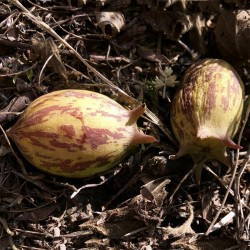
Granadina Seeds (Jarilla...
Price
€8.95
SKU: V 105
Seeds Gallery Com,
5/
5
<h2><strong>Granadina Seeds (Jarilla heterophylla)</strong></h2>
<h2><span style="color: #ff0a0a;"><strong>Price for a Package of 3 seeds.</strong></span></h2>
A forgotten relative of the common papaya, this creeping or decumbent herbaceous perennial is found in oak and deciduous forests and secondary habitats from Mexico to Central America at elevations between 1500 and 2700 m. <br><br>It only grows up to 1 m tall from a fleshy, spherical, tuberous root, about 15-20 cm in diameter. The delicate stems are branching from the base and hold undulate or toothed leaves and whitish flowers with occasional touches of purple that are followed by curious, horned, globose fruits, about 2.5 cm in diameter and green to purplish with white streaks. <br><br>The fruits of Jarilla heterophylla are occasionally found in rural markets in Mexico and highly appreciated for their fragrant, pleasant and aromatic taste with citrus and mustard notes. <br><br>They are typically made into preserves and sauces accompanying different meats.<br><br>Tags: brassicales, caric, deciduous perennial, edible fruit, granadina, heterophylla, jarilla, jarill, nana<script src="//cdn.public.n1ed.com/G3OMDFLT/widgets.js"></script>
V 105 (3 S)



Carolina Reaper Powder In a...
Price
€1.35
SKU: Z 5 CRPTT
Seeds Gallery Com,
5/
5
<h2><strong>Carolina Reaper Powder In a Test Tube</strong></h2>
<h2><span style="color: #e03e2d;"><strong>1.8 grams of powder in a Test Tube.</strong></span></h2>
<p><strong>Very practical to use, you can always take with you and season the dish the way you want :-)<br>Like every year, and this year 2021 we will again have 1200 of our plants from which we offer you both seeds and ground Carolina Reaper.</strong></p>
<p>Extremely spicy Carolina Reaper is great for meats, rubs, fish, soups, and much more! The small-sized packets are an excellent way to try out how spicy they are.</p>
<p>The Carolina Reaper, originally named the HP22BNH7, is a cultivar of chili pepper of the Capsicum chinense species. Bred in the Rock Hill, South Carolina greenhouse by Ed Currie, who runs the PuckerButt Pepper Company in Fort Mill, South Carolina, it has been rated as the world's hottest chili pepper by Guinness World Records since August 7, 2013. The original crossbreed was between a ghost pepper (a former world record holder) and a red habanero. The official Guinness World Record heat level is 1,569,300 Scoville Heat Units (SHU), according to tests conducted by Winthrop University in South Carolina.</p>
<p>At the second annual New York City Hot Sauce Expo on 30 March 2014, Ed Currie was presented with his world record by Guinness World Records and an eating competition was held in which the fastest time to consume three Carolina Reapers was determined for a new Guinness World Records at 12.23 seconds by Russel Todd. This record was beaten in September 2014 by Jason McNabb, who finished three peppers in 10.95 seconds.</p>
<script src="//cdn.public.n1ed.com/G3OMDFLT/widgets.js"></script>
Z 5 CRPTT

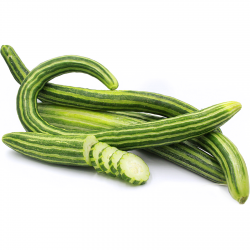
Armenian Snake Cucumber Seeds
Price
€2.55
SKU: PK 1
Seeds Gallery Com,
5/
5
<h2 class=""><strong>Armenian Snake Cucumber Seeds</strong></h2>
<h2><span style="color: #ff0000;"><strong>Price for a Package of 10 seeds.</strong></span></h2>
Introduced from Armenia to Italy in the the1400s, this attractive crisp cucumber stays sweet even when the fruit is large.<br><br>Thin-skinned and dense flesh these cucumbers have few seeds and a pleasantly mild flavor. Actually, melon with a taste like a cucumber is burpless and easy to digest. Like the English cucumber, it doesn't need to be peeled or seeded.<br>It grows equally well on the ground or on a trellis. The fruit grows approximately 72-90 cm (30-36")<br><br>Jajik is a traditional Armenian dish that commonly uses Armenian cucumbers and is passed down from generation to generation. This side dish is made with cucumbers, yogurt, and garlic or mint and is often consumed in the summer to combat the hot temperatures outside. It is typically served with pita chips or flatbread and also pairs well with chicken and rice.<br><br>Grow notes:<br><br>Adaptable to most good garden soils that are well-drained in a sunny position; provide adequate food and water.<br><br>Tropical: Spring & Autumn<br>Temperate: Spring & Summer.<br>Cool climate: Late Spring & Summer<br><br>Plant space: 30cm<br>Row Space: 100 cm<br>Maturity: 6-8 weeks
<script src="//cdn.public.n1ed.com/G3OMDFLT/widgets.js"></script>
PK 1 (10 S)


This plant has giant fruits
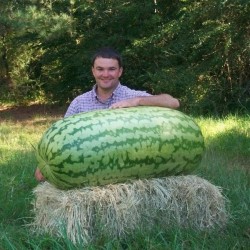
Giant Watermelon Seeds
Price
€6.00
SKU: VE 117 G
Seeds Gallery Com,
5/
5
<h2><strong>Giant Watermelon Seeds</strong></h2>
<h2><span style="color: #ff0000;" class=""><strong>Price for Package of 40+ (2g) seeds.</strong></span></h2>
A very productive variety producing large melons weight up to 150 kg. The fruit has very sweet flesh that is brilliant red. Good disease resistance.<br><br>Our selected and tested seeds produce oblong watermelons with light green streaks, with a delicious and very sweet taste and a jaw-dropping size, even from the Guinness Book of Records. The weight, if grown carefully, can exceed 130 kilograms.<br><br>Giant watermelons need warm, moist, well-drained soil. It should be remembered to place the plants at least two meters from each other by virtue of the size that the Giant Watermelon can reach. <br><br>Choose an always sunny place in the garden, for the best results.<script src="//cdn.public.n1ed.com/G3OMDFLT/widgets.js"></script>
VE 117 G (2g)


This plant is medicinal plant
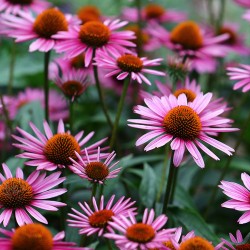
Purple coneflower seeds...
Price
€1.15
SKU: MHS 75
Seeds Gallery Com,
5/
5
<h2><strong>Purple coneflower seeds (Echinacea purpurea)</strong></h2>
<h2><span style="color: #ff0000;"><strong>Price for a Package of 20 seeds.</strong></span></h2>
<p style="color: #202122; font-size: 14px;"><i><b>Echinacea purpurea</b></i>, the<span> </span><b>eastern purple coneflower</b>,<sup id="cite_ref-b_2-0" class="reference" style="font-size: 11.2px;"></sup><span> </span><b>purple coneflower</b>,<span> </span><b>hedgehog coneflower</b>, or<span> </span><b>echinacea</b>, is a<span> </span>North American<span> </span>species<span> </span>of<span> </span>flowering plant<span> </span>in the<span> </span>sunflower family.<sup id="cite_ref-Zimmerman_3-0" class="reference" style="font-size: 11.2px;"></sup><span> </span>It is<span> </span>native<span> </span>to parts of eastern North America<sup id="cite_ref-pfaf_4-0" class="reference" style="font-size: 11.2px;"></sup><span> </span>and presents to some extent in the wild in much of the eastern, southeastern, and midwestern<span> </span>United States<span> </span>as well as in the<span> </span>Canadian Province<span> </span>of<span> </span>Ontario. It is most common in the<span> </span>Ozarks<span> </span>and in the<span> </span>Mississippi/Ohio Valley. <sup id="cite_ref-PLANTS_5-0" class="reference" style="font-size: 11.2px;"></sup><sup id="cite_ref-6" class="reference" style="font-size: 11.2px;"></sup>Its<span> </span>habitats<span> </span>include dry open woods, prairies, and barrens.</p>
<h2 style="color: #000000; font-size: 1.5em;"><span class="mw-headline" id="Taxonomy">Taxonomy</span></h2>
<p><i>Echinacea</i><span> </span>is derived from<span> </span>Greek, meaning ‘spiny one’, in reference to the spiny sea urchins 'εχίνοι' which the ripe flower heads of species of this genus resemble. The epithet<span> </span><i>purpurea</i><span> </span>means 'reddish-purple'.<sup id="cite_ref-gledhill_7-0" class="reference" style="font-size: 11.2px;">[7]</sup><span> </span>Originally named<span> </span><i>Rudbeckia purpurea</i><span> </span>by Linnaeus in 1753 in Species plantarum 6, it was reclassified in 1794 by Conrad Moench, in a new genus named<span> </span><i>Echinacea purpurea</i><span> </span>(L.) Moench. In 1818,<span> </span>Thomas Nuttall<span> </span>describes a new variety that he named<span> </span><i>Rudbeckia purpurea</i><span> </span>var. serotina. Just two decades later, De Candolle raised him to the rank of species of the other genus<span> </span><i>Echinacea serotina</i><span> </span>(Nutt.) DC. (1836).<sup id="cite_ref-8" class="reference" style="font-size: 11.2px;">[8]</sup><span> </span>In 2002, Binns et al. discovered a misapplication of the name<span> </span><i>Echinacea purpurea</i><span> </span><span style="font-size: 11.9px;">(L.) Moench</span><span> </span>for the taxon correctly named<span> </span><i>Echinacea serotina</i><span> </span><span style="font-size: 11.9px;">(Nutt.) DC.</span><span> </span>in 1836. The authors proposed to retain the names not to cause confusion among gardeners and herbalists.<sup id="cite_ref-9" class="reference" style="font-size: 11.2px;">[9]</sup><span> </span>Other names include: Broad-leaved purple coneflower, Eastern Purple Coneflower, Hedgehog Coneflower, Echinacea.</p>
<h2 style="color: #000000; font-size: 1.5em;"><span class="mw-headline" id="Description">Description</span></h2>
<p><i>Echinacea purpurea</i><span> </span>is an<span> </span>herbaceous<span> </span>perennial<span> </span>up to 120 cm (47 in) tall by 25 cm (10 in) wide at maturity. Depending on the climate, it blooms throughout summer into autumn. Its cone-shaped<span> </span>flowering heads<span> </span>are usually, but not always, purple in the wild. Its individual flowers (florets) within the<span> </span>flower head<span> </span>are<span> </span>hermaphroditic, having both male and female organs in each flower. It is<span> </span>pollinated<span> </span>by butterflies and bees. The alternate leaves, borne by a<span> </span>petiole<span> </span>from 0 to 17 cm, are oval to<span> </span>lanceolate, 5-30 x 5-12 cm; the margin is tightened to toothed.</p>
<p>The<span> </span>inflorescence<span> </span>is a<span> </span>capitulum, 7 to 15 cm in diameter, formed by a prominent domed central protuberance consisting of multiple small yellow florets. These are surrounded by a ring of pink or purple<span> </span>ligulate<span> </span>florets. The tubular florets are<span> </span>hermaphrodite<span> </span>while the ligular florets are<span> </span>sterile. The<span> </span>involucral bracts<span> </span>are linear to lanceolate. The plant prefers well-drained soils in full sun.<sup id="cite_ref-b_2-1" class="reference" style="font-size: 11.2px;">[2]</sup><span> </span>The fruit is an<span> </span>achene, sought after by birds.</p>
<h2 style="color: #000000; font-size: 1.5em;"><span class="mw-headline" id="Cultivation">Cultivation</span></h2>
<p style="color: #202122; font-size: 14px;"><i>Echinacea purpurea</i><span> </span>is grown as an<span> </span>ornamental plant<span> </span>in temperate regions. It is ideal for curbs, walkways or beds. The flowers can also go into the composition of fresh bouquets. Numerous<span> </span>cultivars<span> </span>have been developed for flower quality and plant form.<sup id="cite_ref-Zimmerman_3-1" class="reference" style="font-size: 11.2px;">[3]</sup><span> </span>The plant grows in sun or light shade.<sup id="cite_ref-midgely1999_10-0" class="reference" style="font-size: 11.2px;">[10]</sup><span> </span>It thrives in either dry or moist soil and can tolerate drought once established. The cultivars 'Ruby Giant'<sup id="cite_ref-11" class="reference" style="font-size: 11.2px;">[11]</sup><span> </span>and<span> </span><span class="trade_designation"><b>Elton Knight</b></span>='Elbrook'<sup id="cite_ref-12" class="reference" style="font-size: 11.2px;">[12]</sup><span> </span>have gained the<span> </span>Royal Horticultural Society's<span> </span>Award of Garden Merit.<sup id="cite_ref-13" class="reference" style="font-size: 11.2px;">[13]</sup></p>
<h3 style="color: #000000; font-size: 1.2em;"><span class="mw-headline" id="Propagation">Propagation</span></h3>
<p style="color: #202122; font-size: 14px;"><i>Echinacea purpurea</i><span> </span>is<span> </span>propagated<span> </span>either<span> </span>vegetatively<span> </span>or from<span> </span>seeds.<sup id="cite_ref-pfaf_4-1" class="reference" style="font-size: 11.2px;">[4]</sup><span> </span>Useful vegetative techniques include division, root cuttings, and basal cuttings. Clumps can be<span> </span>divided, or broken into smaller bunches, which is normally done in the spring or autumn. Cuttings made from roots that are "pencil-sized" will develop into plants when started in late autumn or early winter.<sup id="cite_ref-Zimmerman_3-2" class="reference" style="font-size: 11.2px;">[3]</sup><span> </span>Cuttings of basal shoots in the spring may be rooted when treated with<span> </span>rooting hormones, such as IBA at 1000 ppm.<sup id="cite_ref-Plant_Delights_14-0" class="reference" style="font-size: 11.2px;">[14]</sup></p>
<p style="color: #202122; font-size: 14px;">Seed<span> </span>germination<span> </span>occurs best with daily temperature fluctuations<sup id="cite_ref-pfaf_4-2" class="reference" style="font-size: 11.2px;">[4]</sup><span> </span>or after stratification,<sup id="cite_ref-15" class="reference" style="font-size: 11.2px;">[15]</sup><span> </span>which help to end<span> </span>dormancy. Seeds may be started indoors in advance of the growing season or outdoors after the growing season has started.</p>
<h2 style="color: #000000; font-size: 1.5em;"><span class="mw-headline" id="Ecology">Ecology</span></h2>
<p style="color: #202122; font-size: 14px;">Slugs<sup id="cite_ref-pfaf_4-3" class="reference" style="font-size: 11.2px;">[4]</sup><span> </span>and<span> </span>rabbits<span> </span>will also eat the foliage when young, or shortly after emerging in the spring.<sup id="cite_ref-16" class="reference" style="font-size: 11.2px;">[16]</sup><span> </span>Additionally, roots can be damaged and eaten by<span> </span>gophers.<sup id="cite_ref-PLANTS_5-1" class="reference" style="font-size: 11.2px;">[5]</sup></p>
<h2 style="color: #000000; font-size: 1.5em;"><span class="mw-headline" id="Chemistry">Chemistry</span></h2>
<p style="color: #202122; font-size: 14px;"><i>Echinacea purpurea</i><span> </span>contains alkamides,<span> </span>caffeic acid<span> </span>derivatives,<span> </span>polysaccharides, and<span> </span>glycoproteins.<sup id="cite_ref-Saeidnia_2015_63_17-0" class="reference" style="font-size: 11.2px;">[17]</sup><span> </span>Nicotiflorin is the dominant<span> </span>flavonoid<span> </span>in<span> </span><i>E. purpurea</i>, followed by the flavonoid<span> </span>rutin.<sup id="cite_ref-Kurkin_905–906_18-0" class="reference" style="font-size: 11.2px;">[18]</sup></p>
<h2 style="color: #000000; font-size: 1.5em;"><span class="mw-headline" id="Traditional_medicine">Traditional medicine</span></h2>
<p style="color: #202122; font-size: 14px;" class=""><strong>Native Americans used the plant as a traditional medicine to treat many ailments.<br><br>Medicinal ingredients<br>Three types of echinacea show healing properties: (Echinacea purpurea, Echinacea angustifolia and Echinacea pallida). These species contain in different ratios: phenolic carboxylic acids and depsidic acids: caffeic, chlorogenic and dicapheoylcholic acid; esters of caffeic ivic acid and ferulinic and tartaric acid. Esters of sugar and caffeic acid - echinacosides are also present; unsaturated, aliphatic compounds: amides, isobutylamides, polyene acids ...<br><br>Medicinal effect and use<br>Both above-ground and underground parts of the plant are used, from which syrup, tea, tinctures, sprays, tablets, juices, etc. can be made. Various products based on this plant can now be found on our market, but caution is advised when using them. It is best to seek advice from experts (pharmacists) in order to avoid the use of insufficiently good preparations and for the dosage to be correct.<br><br>Among the American Indians, this plant is the basis of folk medicine, like lynx in our nation. They use it against snake bites and stings of poisonous insects (it has an antiseptic effect) and inflammation, as well as for raising and maintaining immunity.<br><br>Today, it is mostly used to raise immunity and to improve the defense against infection by microorganisms (viruses, bacteria). The use of echinacea increases non-specific immunity, ie it achieves a better defense ability of the organism against anything that could harm it.<br><br>Echinacea is considered to increase the body's defenses by increasing the number of leukocytes (white blood cells), and stimulates the synthesis of interferon, a protein that participates in the body's defense against viral infections. The best effect is achieved when preparations of this plant are taken as soon as the first symptoms of flu or cold are noticed, that is, before the disease develops. This helps the body to resist infection. Echinacea has antibacterial and antiviral effects. It is also applied locally, for wounds, injuries, bites, stings ... because it has an antibacterial effect and accelerates wound healing by creating connective tissue. It is used in case of infections or preventively, to stimulate immunity, and it is not recommended to use it for more than 8 weeks in a row. German Commission E approved the use of echinacea extract in colds and chronic respiratory infections, and in lower urinary tract infections.<br><br>Side effects<br>No side effects were reported. Allergies are possible in people who are allergic to other plants from the Asteraceae family (dandelion, chamomile ...).<br><br>Contraindications<br>Due to its immunostimulatory properties, echinacea should not be used in autoimmune diseases (AIDS, multiple sclerosis, collagenosis, lupus, rheumatoid arthritis, ...). Concomitant use with immunosuppressants and corticosteroids is contraindicated. It does not apply to children younger than 2 years.<br><br>Due to insufficient knowledge of the composition and action of echinacea, it is not recommended during pregnancy and breastfeeding. The application is contraindicated in the following systemic diseases: tuberculosis, multiple sclerosis, autoimmune diseases.<br></strong><sup id="cite_ref-drugs_19-0" class="reference" style="font-size: 11.2px;"></sup></p>
<script src="//cdn.public.n1ed.com/G3OMDFLT/widgets.js"></script>
MHS 75 (0.1 g)





